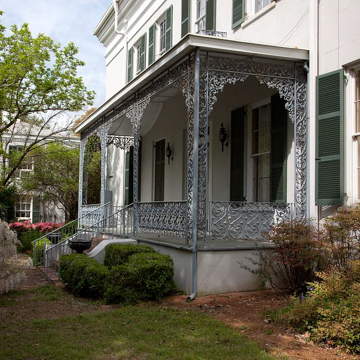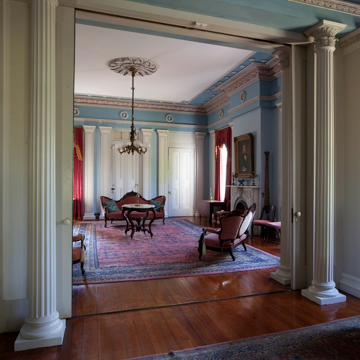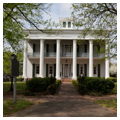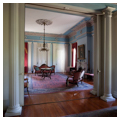You are here
Sturdivant Hall Museum
Sturdivant Hall is a premier expression of late antebellum neoclassical design in Alabama. Tradition credits its construction to local builder Thomas Helm Lee. Yet whether he actually produced the design is open to question; striking similarities of scale, massing, form, and detail to some of the domestic work of Philadelphia architect Stephen Decatur Button (1813–1897) suggest his influence, if not his direct involvement. Button was active in nearby Montgomery in pre-Civil War Alabama, preparing plans for the 1846 statehouse, the 1856 Central Bank of Alabama, and at least one major residence.
Like two of Button’s residential designs, Montgomery’s Knox mansion and the Thomas Hoxey House in Columbus, Georgia, Sturdivant Hall presents a monumental, eastward-facing hexastyle portico with fluted columns topped by cast-iron capitals modeled on the Tower of the Winds order. A recessed entry, framed by a pair of attenuated columns in antis that repeat in miniature the Tower of the Winds motif, provides the visual focal point for the facade. Above, a balcony enclosed by a lacelike cast-iron railing runs the length of the second floor. Tall jib windows, eight in total above and below, may be opened to the floor in warm weather.
A wide, denticulated entablature continues from the colonnade around to the rear of the mansion where the classical theme persists, but in a relaxed way that defers to everyday household activities. Here, a recessed Tuscan portico set between two tiers of cabinet-like service rooms overlooks a courtyard flanked by brick dependencies. Behind the two great pillars, however, door and window openings are arranged as function dictated, while to one side a wooden service stair climbs to an upper gallery graced with the same cast-iron railing to be seen on the front balcony. The otherwise austere side elevations of the mansion are also enlivened by ornamental ironwork: a porch on the south side, with a canopy roof that sweeps up to a second-floor balcony, and on the north side, yet another balcony, this time cantilevered from a floor-length upstairs window.
Departing from the through-hall interior arrangement customary in the South, the lofty center hall turns left at midpoint towards a side entrance only slightly less formal than the main entry. The principal interior spaces are grouped about this L-shaped axis: double drawing rooms to the north of the main hall, with a sitting room/work room adjoining at the rear; on the south, a library and dining room flanking the side hallway where a broad stair rises in a single long flight to the bedrooms above. Woodwork and decorative plasterwork throughout reflect the influence of major pattern books of the time. Door surrounds are based on Samuel Sloan’s The Model Architect (1852), while Grecian pocket doors between the parlors derive from Plate 7 of Minard Lafever’s The Beauties of Modern Architecture, which enjoyed popularity for over two decades after its first appearance in 1835. The ornate gasoliers, manufactured by Cornelius and Baker of Philadelphia, were installed throughout the house. Trompe l’oeil painted wall panels were located in the hallway and ascending the stair. The second-floor plan, originally cruciform, saw the enclosure of one of its arms during the early twentieth century. From the upstairs hall, a second stair climbs to the attic, where yet another flight corkscrews up to a rooftop observatory.
Originally the extensive grounds surrounding this suburban villa (it was never a plantation) included slave dwellings, stables, a poultry house, and other ancillary structures now lost. Still remaining are a frame carriage house beside a two-story brick kitchen and, standing opposite it across the rear courtyard, a multipurpose structure that served as smokehouse, wine cellar, and storage. The buildings are stuccoed and scored as faux ashlar to match the main residence. Sometime before 1887, a small brick service wing was built off the northwest rear corner of the mansion.
Sturdivant Hall was completed around 1856 as a town residence for planter Edward T. Watts, whose extensive landholdings lay south of Selma. Less than a decade later, during the latter part of the Civil War and for reasons not clearly understood, Watts sold the mansion and moved to Texas. The new owner, a banker named John M. Parkman, lived here only a few years until his untimely and mysterious death. In 1870, merchant Emile Gillman acquired the house; it remained in the hands of his descendants for more than eighty years.
In 1957, a $50,000 bequest from local philanthropist Robert Sturdivant—for whom the house is now named—was matched with municipal and county funds to develop the mansion as a museum under the auspices of the City of Selma. Advisors to the subsequent refurbishing were architect Marvin Schwartz of New York and architectural designer Earl Hart Miller of Natchez. At this time, gray and white marble flagging was introduced into the main hallway, replacing a wooden floor, and the trompe l’oeil decorative wall treatment was replaced by relief molding.
Embellishments to the grounds since Sturdivant Hall became a house museum include a cast-iron gazebo and ornamental garden screen, the latter incorporating late-nineteenth-century iron work from the grounds of the Alabama State Capitol (AL-01-101-0004). More recent acquisitions, relocated to the grounds to prevent their destruction, are a small, temple-fronted “apothecary” building moved from Roseland plantation in neighboring Marengo County, as well as the plantation’s five-hole privy.
References
Burkhardt, E. Walter. “Watts-Parkman-Gillman House,” Dallas County, Alabama. Historic American Buildings Survey (HABS No. AL-700), 1934. National Parks Service, U.S. Department of the Interior, Washington, D.C.
Hammond, Ralph. Ante-bellum Mansions of Alabama. New York: Bonanza Books, 1951.
Writing Credits
If SAH Archipedia has been useful to you, please consider supporting it.
SAH Archipedia tells the story of the United States through its buildings, landscapes, and cities. This freely available resource empowers the public with authoritative knowledge that deepens their understanding and appreciation of the built environment. But the Society of Architectural Historians, which created SAH Archipedia with University of Virginia Press, needs your support to maintain the high-caliber research, writing, photography, cartography, editing, design, and programming that make SAH Archipedia a trusted online resource available to all who value the history of place, heritage tourism, and learning.





















